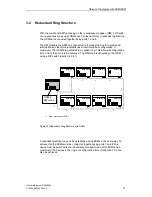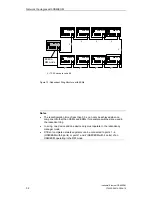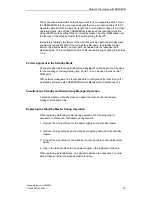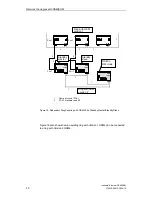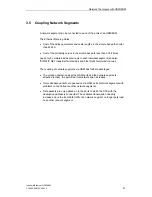
Interfaces, Displays and Operator Controls
Industrial Ethernet OSM/ESM
C79000-Z8976-C068-10
45
4.1.3
Properties of the TP/ITP Ports
Link Control
OSMs/ESMs monitor the connected TP/ITP cable segments for short-circuits or
wire breaks using regular link test pulses complying with the 100BASE-TX
standard. OSMs/ESMs do not send data to a segment from which they are not
receiving link test pulses. An unused interface is taken to be a wire break since the
device without power cannot send link test pulses.
Auto Polarity Exchange
If the receive cable pair is incorrectly connected (RD+ and RD- swapped over), the
polarity is automatically reversed.
Autonegotiation Mode
The TP/ITP ports of OSM/ESM are set to the autonegotiation mode.
They automatically detect the transmission rate (10 or 100 Mbps) at which the
attached device or attached network segment operates and set themselves to this
rate. If the partner device also supports the autonegotiation mode, the devices
further negotiate whether they will exchange data with each other in the half duplex
or full duplex mode.
Note
If the partner device connected to a port of an OSM/ESM does not support the
autonegotiation mode (for example OSM Version 1), the port of the partner device
must be set to half duplex mode.
Autocrossover Function
OSMs/ESMs with digital inputs are capable of switching over their TP/ITP ports
automatically between MDI and MDI-X pinning; in other words, they can cross over
the send and receive data internally, when necessary.
This means that regardless of the port type of the device you are connecting and
the type of Ethernet cable, a connection can be established. Crossover cables are
not necessary.
Summary of Contents for ESM
Page 32: ...Industrial Ethernet OSM ESM C79000 Z8976 C068 10 28 Network Topologies with OSM ESM 3 ...
Page 94: ...Industrial Ethernet OSM ESM C79000 Z8976 C068 10 90 ...
Page 96: ...Industrial Ethernet OSM ESM C79000 Z8976 C068 10 92 ...
Page 98: ...Index Industrial Ethernet OSM ESM 94 C79000 Z8976 C068 10 ...

